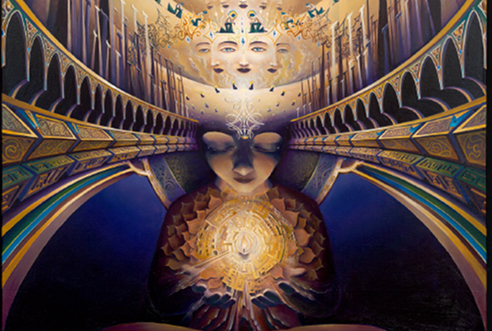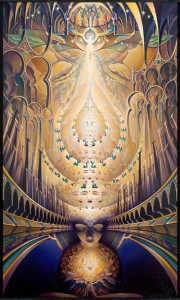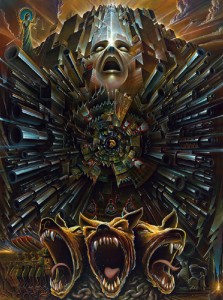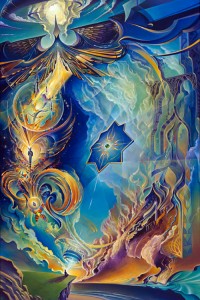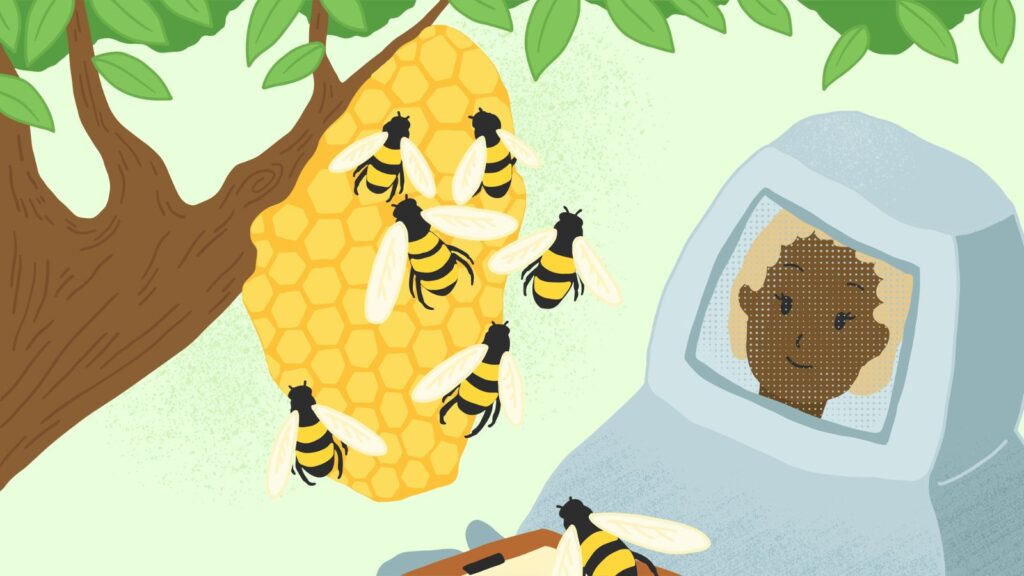Michael had suggested the Rose Cafe in Venice. We’d seen one another around for years, but this would be our first conversation. We sat outside in partial shade. We had the patio to ourselves. I recorded on my iPad. But what was supposed to be an interview became a different kind of conversation, meandering and back and forth with more comments and responses than outright questions. We decided to scrap the recording and write back and forth in email. The writing, of course, is steeped in the themes and concepts we explored at the Rose: from the limitation of rigid structure to forging a unique visual language, to meaning and the artist’s inspiration. Here is a little window into the thoughts that fuel Michael’s unique paintings.
Lily: Can you tell me about the current direction of your work, conceptually, and what direction your thoughts have been moving in, in conjunction with your work?
Michael: I like my work to evolve and push into new territory. I like experimentation, trying new things, creating the unexpected. Sometimes I do that. Sometimes I’m following a thread that passes through multiple pieces. I look at paintings like Birth of a Star, The Myth of Freedom, Illumination, The Glass Onion – some of my best work I think – and they have an underlying similarity – a beauty of a sort of non-dogmatic spirituality.
However, it’s been mentioned at times that there is a bittersweetness to aspects of them. They aren’t simply pretty for pretty’s sake. It’s not all niceties, platitudes, pleasantries. Sometimes, in my work, people see the grand aria – the epic vista… And there’s a reason I can take it to that place. It’s an echo, a result, of introspection, of sifting through the ashes, the dirt, the dark edges.
Lately, I’ve wanted to express more of those ‘dark edges’. There’s various reasons. The main is this: if art is all a reflection and all people see are pretty pictures – or, at the very least, pictures which are so grand that the dark edges are seen only as supportive frills – then I really am doing people a disservice with my work. See – the world we live in – it’s a vast grey area of ups and downs. War and corporate greed and a media machine that seems to overwhelm us with it’s desire for our attention and our dollars. It can seem rather heavy. I imagine what it’s like perhaps being 19 or 20 these days. It’s a different world than that which I grew up in. The college diploma no longer guarantees a job. Your parents have either been unemployed or fearing unemployment, or maybe its your friend’s parents… The government has always been all up in your grill – way more than when I was younger. Then there’s the endless chatter of the media machine. Not to mention the ‘war on terror’ which seems to just go on and on. It’s an endless war…. So I get it – it’s really quite a phenomenon. It’s intense. And it’s a different intense than, say 1998. Now, I’m not being nostalgic, I’m just looking at differences. And recognizing them. And trying to understand the shifting waves of a culture… and reflect that. So the paintings I’ve been working on now – they reflect some of this and explore some of these feelings in a way that I haven’t in the past.
I decided to start looking at some of the things that feel more… current, I suppose, and looking at them through the same lens I look through everything: the lens that sees the spectrum of the human experience – the high and low, up and down, small and big, the struggle and release. The way that humans try to control other humans. The whole thing. And I wanted to look at war, at media, at this NOW…. at what we’re doing to ourselves.
So that’s sort of where I’m going right now in my work… To be honest, there’s a lot more black. And it feels a lot more honest.
My initial impulse is, “yes, black, this points to everything you’ve just said,” but no sooner has the thought broken into awareness that I wonder why. Why dark colors to convey this? Can you talk a bit about the light/dark dichotomy – visually and philosophically – and how you understand it?
You know, I wouldn’t even say it’s just light and dark… You know: if you paint your ceiling a light blue, your head will have an uplifted sense about it because your peripheral vision will create a sensation of ‘sky’ around that. It’s a curious thing – how we experience color and light. If we have a lit candle in a darkened room, we feel warmth and illumination from the candle and a denseness to the space around it. Our vision actually fills in the darkened spaces with shapes, patterns, however subtle. If we put that same candle in a brightly lit room, then the experience of the candle is entirely different. We’ve had this relationship to color for so long – from the blues and purples of royalty to pastel colors in the spring that echo the first beginnings of color that we see in bulbs blooming. Some colors seem rich, some pale. But it’s all only in relation to each other. The same goes with light and dark. In a painting for instance, the light only feels BRIGHT if there is a subtable darkness that balances it. Otherwise, it’s washed out and doesn’t MEAN anything.
You’ve spoken eloquently about finding your own visual language. How have you developed that language, and how do you spot a unique visual language in another artists work?
A personal language is interesting… it’s unique. Every artist has it. It’s in the curve of a line, a spiral, the authentic experience of a corner or an edge. It’s something that you know – an expression of a part of you. It’s a bit like dancing: everyone has their own flow, their own style… How have I developed it? Only through years of practice. Of finding the curve that brought me – that brings me – the most happiness, that makes me smile.
How do I see that in the work of another artist? Well, I suppose if I see a Kandinsky or a Monet, I usually know it’s by that artist. It is a theme – a color palate, a consistency of brushwork, a line, a curve…
I think the longer one listens to one’s own artistic voice, the more one can experience this visual language that allows for their own personal expression. Of course, the danger is falling into habits where we go into default mode – repeating patterns, symbols, etc because it’s easy – all the time. It’s good to break it up. Try new things. Add new motifs, new ways of expressing things. Each new bit is another new facet of oneself… another expression…
I understand that a lot of your formation as an artist was in solitude, without the regular influence of peers and mentors. You’ve really managed to develop and refine a unique thread, a task which I imagine takes even greater discipline in solitude. Would you agree with that? What were your biggest influences in that time, and what, if anything, offered you guidance?
Solitude… there’s been a lot of that in my life and a vast amount of, well, not solitude. The dance between the two states has been, I think, extremely important to my path. The busy-ness of the world – people and places and things – it’s lovely to dance with it and dance through it. But to make great art, it really requires a stillness within that movement. There is a subtlety that needs to be nurtured, fostered, in order to get to the sweet spot within that guides the creative flow.
What I mean is: if you want to make loud art with big brushes without much pause – and there is a place for that too – then I think it’s easier to make that anywhere. To listen for one’s own voice – to see what it has to say and to follow it from the broad brush stroke down to the finest pinpoint – that requires extracting oneself from the sea – the marketing, the internet, the friends – and really letting go into that void. We are bombarded at all times of the day with hooks that try to draw us back in to the game of need, desire, etc. The desire to be loved, accepted. To be cool and hip. To be shiny and sparkly and not to dig too much into ourselves.
I feel like I go out into the world and sort of gather data: ideas and inspirations from interactions and travel and all that. Then I go back to my studio and sort it out. I look for a reflection… I look at what I’m trying to say, what I want to mean in this world. And it takes an incredible amount of patience with oneself.
Look – these days we’re connected to everyone all the time. So there are times – and every artist feels this – when it looks like all our friends are off doing cool things and we’re at home painting away… and the painting is a mess, we’ve been working on it for weeks… plugging away. And we’re missing all the fun stuff and maybe the rest of the world has forgotten about us… There’s a patience involved in that process. A tenderness that is a part of the ‘I don’t need to go anywhere….’ That takes discipline. But it also takes having a vision that is worth seeing through. You have to WANT it.
That, I think, was my biggest influence when I was younger. That I had seen where I could go with a painting. It’s what has driven me ever since. It’s that long meditation on a theme and bringing it to the deepest and highest point, space, experience that I can – that I am capable of. And each one is like ‘ok, maybe I’ll approach it from this direction, or from this direction.’ It’s that thread which I’ve traced time and again in my work.
You mentioned meaning, tell me, do you think meaning is a thing that is found – searched for – or a thing that is made (or, perhaps, some combination thereof)?
Meaning is the pairing of an idea with an object, an image, a thing. How could anything ‘mean’ something without us giving it meaning? And that meaning is completely relative. I don’t intend to say that we’re acting as some supreme meaning-creator. But, humans with their human minds, they search for meaning – they try to find meaning in everything. Does it have meaning? Does anything? We seek to understand patterns so out of the chaos of life we find patterns which offer some comfort, some sense of identity, some rhythm and, out of that, create a sense of identity. Hopefully we find patterns and meaning that help us to lead healthier, happier, more loving lives.
If we ever think we’ve ‘found’ meaning… I think that’s just a creation as well. What it means to us will be different to another. Maybe ten other people agree with us as to the meaning, maybe a hundred, maybe 20 million… but still: it’s a made up meaning. A cross? An OM? A circle? A square… All of these things… they are symbols with meaning imbued into them. Perhaps they echo other patterns in our lives: patterns in nature, in the stars. It’s interesting: this game of creating “meaning”… What does any of it mean? Who cares! Do your best to live a happy healthy life – help others to do the same… and I think that’s all there is. Everything else is a story we make up along the way.
How does it feel when people come to you with personal experiences and interpretations around your work?
I think it’s neat. Everyone has their own story about everything. Sometimes their story is really a completely different view. That’s cool. I’d rather hear what they have to say then slant their view with my own. I do think it’s interesting how people project ideas onto my work – sort of woo-woo spiritual stuff and it clutters it all up with belief systems that I’m not at all interested in. As far out as my paintings can feel, to me they are merely grounded reflections of the personal process.
With regards to personal process, Audre Lorde, one of my favorite writers, proclaims that “the quality of light by which we scrutinize our lives has direct bearing upon the product which we live, and upon the changes which we hope to bring about through those lives.” What do you think of this idea? What do you think are some approaches to personal process (inner work?) that you find fruitful that also avoid being woo-wooy?
Incidentally, right before that, she states ‘Poetry is not a luxury.’ And, I think, this is true for beauty, for grace. And I don’t mean idealized visions of beauty or whatever – even just keeping a clean house, a mindfulness about one’s kitchen. I think the more we practice awareness, the more we find these small things greatly contribute to the quality of our lives. And it’s not even that we have to create complicated stories of ‘sacredness’ around these acts. The more we do that, the more we start to separate things again into ‘sacred’ and ‘not sacred’. There’s no real value in that. Ego is stoked to be in the know of the sacred things and allow itself, in whatever small way, to feel better because of that. So if we give ego a little less to chew on there then I think, the better off we are.
Awareness doesn’t require mumbo jumbo. One of the traps of the New Age spiritualism is that there are all these levels that are created: the Metahedron Cube level and the Chakra level and the auric something or other level… And some will say ‘I’m feeling it’ and others will say ‘I want to feel it’ and these divisions get made as people try to usher others into a cult of belief systems. Yet… it just serves to divide and create layers of idea – ideas placed around experiences, projections of experiences, desires for connection, to be part of a group – that further distances people from simply being able to experience NOW. HERE. It’s an ‘awareness’ that has no practical meaning. It doesn’t work in the here and now. It’s just fluff and filler. Want to feel more aware? Do the dishes, go for a walk, sit for a bit, focus on your breath, feel your hands, your feet. Dance.
I’ve had my fair share of interestingly far out experiences – and continue to do so. You know how it is: there was this experience and it felt like this, it had this quality, and so on. That was interesting. But I’m not interested in adding layers of story to it – did I attain a frequency shift or tap into the next level something or other… Silly stuff. Awareness of the here and now, poetry of the present moment, the quality of the light that shines on my present moments, is the most important thing.
The tools I find fruitful in this are the tools I have with me all the time, in every moment: Breathing. Relaxation. Mindfulness. Breath, body, sensation… there’s not much more than that. That’s what we’ve got to work with….. And then, along the way, we check things out: how we feel, what we are experiencing. Sometimes it’s a gentleness that is required. Sometimes we need to shake things up – like a summer storm. Or, in the metaphor of ‘light’ – sometimes it’s a soft candle that works best and sometimes we need all the glare of a spotlight – or the sun.
So working with that simple awareness of our relationship to this world we live in is, for me, the best approach.
